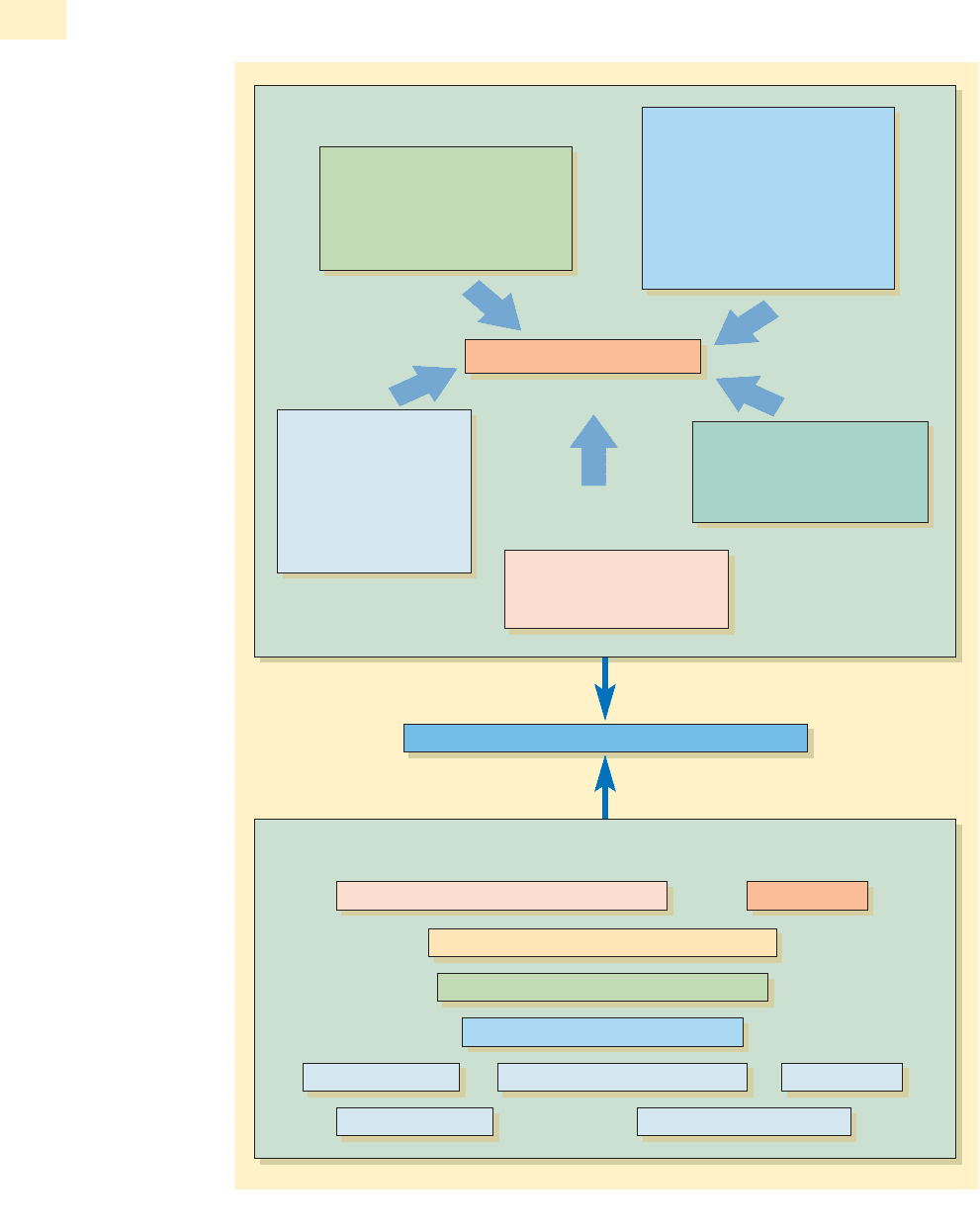Mullins L.J. Management and organisational behaviour, Seventh edition
Подождите немного. Документ загружается.


‘Managing Socio-technical Change: a Configurational
Approach to Technology Implementation’, in Benders,
J., de Haan, J. and Bennett, D. (eds) The Symbiosis of
Work and Technology, Taylor & Francis (1995).
61. This case study is derived from a longitudinal analysis
of strategic organizational and technological change
within the public house retailing business of a multi-
national company. The author would like to
acknowledge the contribution of his two co-researchers
to that research project. See Preece, D., Steven G. and
Steven, V. Work, Change and Competition: Managing for
Bass, Routledge (1999).
62. Zuboff, S. In the Age of the Smart Machine, Heinemann
(1988).
63. Smith, S. ‘How Much Change in Store? The Impact of
New Technologies on Managers and Staffs in Retail
Distribution’, in Knights, D. and Willmott, H. (eds) New
Technology and the Labour Process, London: Macmillan
(1988).
64. Quoted in McLoughlin, I. and Clark, J. Technological
Change at Work, Second edition, Open University Press
(1994), p. 200.
65. McLoughlin and Clark, ibid., p. 201.
66. Ibid.
67. Du Gay, P. ‘“Numbers and Souls”: Retailing and the De-
differentiation of Economy and Culture’, British Journal
of Sociology, 44, 4, 1993, p. 574.
68.
I wish to acknowledge the contribution of my co-
researcher, Ken Clarke, to the collection and analysis of
the data upon which this case study is based. See also
Preece, D. and Clarke, K. ‘Company Intranets, Technology
and Texts’, in Preece, D. and Laurila, J. (eds) Technological
Change and Organizational Action, Routledge, 2003.
69. See, for example, du Gay, P. ‘Making Up Managers:
Enterprise and the Ethos of Bureaucracy’, in Clegg, S.
and Palmer, G. (eds) The Politics of Management
Knowledge, Sage (1996).
70. Preece, D. (1995), op. cit.
71. Child, J. ‘Managerial Strategies, New Technology and
the Labour Process’ in Knights, D., Willmott, H. and
Collinson, D. (eds) Job Redesign: Critical Perspectives on
the Labour Process, Gower (1985).
72. Castells, M. The Information Age: Economy, Society and
Culture. Volume I, The Rise of the Network Society;
Volume II, The Power of Identity; Volume III, End of
Millennium. Second edition, Blackwell (2000).
73. Castells, Vol. I, op. cit.
74. Ibid, p. 77.
75. Ibid.
76. Ibid., pp. 51–2.
77. Ibid., p. 187.
78. Ibid., p. 501.
79. Piore, M. and Sabel, C. The Second Industrial Divide:
Possibilities for Prosperity, Basic Books (1984).
80. Ernst, D. ‘Inter-firms Networks and Market Structure:
Driving Forces, Barriers and Patterns of Control’,
University of California, Berkeley, BRIE research paper,
cited in Castells, Volume I (2000), op. cit.
81. Castells, op. cit., p.70.
82. Ibid., p. 71.
83. Ibid., pp. 71–2.
84. Ibid., pp. 75–6.
85. Ibid.
86. Ibid., p. 214.
87. Ibid., p. 500.
88. Ibid., p. 406.
89. Ibid., p. 359.
90. Ibid.
91. Fitzpatrick, T. ‘Critical Theory, Information Society and
Surveillance Technologies’, Information, Communication
and Society, vol. 5, no. 3, 2002, p. 360. See also Noria,
N. and Eccles, R. (eds) Networks and Organisations,
Harvard Business School Press (1992); Snow, C., Miles,
R. and Coleman, H. ‘Managing 21st-century Network
Organizations’, Organizational Dynamics, vol. 20, no. 3,
1992, pp. 5–21; Fulk, J. and DeSanctis, G. ‘Electronic
communication and changing organizational forms’,
Organization Science, vol. 6, no. 4, 1995, pp. 337–49;
Agre, P. ‘Real-Time Politics: The Internet and the
Political Process’, Information Society, vol. 18, 2002, pp.
311–31; McLoughlin, I., Preece, D., and Dawson, P.
‘From Essex to Cyberspace: Virtual (Organisational)
Reality and Real (Organisational) Virtuality’, Labour
and Industry, vol.13, no. 3, 2003.
92. Fitzpatrick, ibid., p. 361.
93. Ibid., p. 363.
94. Ibid., p. 362.
CHAPTER 17 TECHNOLOGY AND ORGANISATIONS
695
FT
Use the Financial Times to enhance your understanding of the context and practice of management and
organisational behaviour. Refer to articles 18 and 29 in the BUSINESS PRESS section at the end of the
book for relevant reports on the issues explored in this chapter.

MANAGEMENT OF
HUMAN RESOURCES
Part 7
Part 2
THE
ORGANISATIONAL
SETTING
Part 3
THE ROLE OF
THE MANAGER
Part 6
ORGANISATIONAL
STRUCTURES
Part 8
IMPROVING
ORGANISATIONAL
PERFORMANCE
Part 5
GROUPS AND
TEAMWORK
Part 1
MANAGEMENT AND
ORGANISATIONAL
BEHAVIOUR
Part 4
THE
INDIVIDUAL
Part 7
MANAGEMENT
OF HUMAN
RESOURCES

Performance appraisals

There is always a choice about the way you do
your work, even if there is not a choice about the
work itself. We can choose the attitude we bring
to our work.
Stephen Lundin, Harry Paul and John Christensen
Fish: A Remarkable Way to Boost Morale and Improve Results, Hyperion Press
(2001). The story of the world famous Pike Place Fish Market, Seattle
I like work: it fascinates me. I can sit and look at it
for hours. I love to keep it by me: the idea of
getting rid of it nearly breaks my heart.
Jerome K. Jerome
Three Men in a Boat, Arrowsmith (1889)
To make the best use of people as a valuable
resource of the organisation, attention must be
given to the relationship between staff, and the
nature and content of their jobs. The work
organisation and the design of jobs can have a
significant effect on staff and their levels of
performance and productivity. Attention needs
to be given to the quality of working life. The
manager needs to understand how best to
make work more satisfying for staff and to
overcome obstacles to effective performance.
LEARNING OUTCOMES
After completing this chapter you should be able to:
explain the meaning, nature and main dimensions of
job satisfaction;
detail a framework of study;
explore the nature of stress at work;
detail main approaches to improving work
organisation and job design;
examine broader organisational approaches to
improved job design;
evaluate main influences on job satisfaction;
review the relationships between job satisfaction and
improved work performance.
JOB SATISFACTION AND
WORK PERFORMANCE
18
Photo: with permission from Microsoft Corporation

Attempting to understand the nature of job satisfaction and its effects on work per-
formance is not easy. Job satisfaction is a complex and multifaceted concept, which can
mean different things to different people. Job satisfaction is usually linked with moti-
vation, but the nature of this relationship is not clear. Satisfaction is not the same as
motivation. Job satisfaction is more of an attitude, an internal state. It could, for
example, be associated with a personal feeling of achievement, either quantitative
or qualitative.
One view is that job satisfaction is necessary in order to achieve a high level of moti-
vation and performance. However, although the level of job satisfaction may well
affect strength of motivation, this is not always the case. The content theories of moti-
vation (discussed in Chapter 12) tend to assume a direct relationship between job
satisfaction and improved performance. For example, Herzberg’s two-factor theory is
essentially a theory of job satisfaction.
1
However, the process theories of motivation
recognise the greater complexity of work motivation and consider in more detail the
wider relationships involving motivation, satisfaction and performance.
In recent years attention to job satisfaction has become more closely associated with
broader approaches to improved job design and work organisation, and the quality of
working life movement, and with stress and the work/life balance.
The relationship between job satisfaction and performance is an issue of continuing
debate and controversy. One view, associated with the early human relations approach,
is that satisfaction leads to performance. An alternative view is that performance leads
to satisfaction. Luthans, however, suggests that:
Although most people assume a positive relationship, the preponderance of research evidence
indicates that there is no strong linkage between satisfaction and productivity.
2
Bassett also suggests that research studies have found only a limited relationship
between satisfaction and work output and offer scant comfort to those seeking to con-
firm that a satisfied worker is a productive worker. Staff turnover and absenteeism are
commonly associated with dissatisfaction but although there may be some correlation
there are many other possible factors. There appear to be no universal generalisations
about worker satisfaction or dissatisfaction that offer easy management solutions to
problems of turnover and absenteeism. Bassett suggests that it is primarily in the realm
of job design that opportunity for constructive improvement of worker satisfaction
appears to be high.
3
(Job design is discussed later in this chapter.)
You may recall that Herzberg identified a sense of achievement as affecting feelings
of job satisfaction. Reeves draws attention to the relationship between accomplishment
at work and the need to ‘work harder’.
All this busy-ness and stress is creating more heat than light. It is a sign not of work being too
hard but too shallow. Human nature is driven by a desire to accomplish things, and so the fewer
opportunities for accomplishment a job contains, the more likely we are to fill the void by tearing
around in a frenzy in an effort to persuade ourselves and others that our work has a purpose,
that it is important.
4
There is some doubt whether job satisfaction consists of a single dimension or a
number of separate dimensions. Some workers may be satisfied with certain aspects of
their work and dissatisfied with other aspects. There does, however, appear to be a posi-
700
PART 7 MANAGEMENT OF HUMAN RESOURCES
THE MEANING AND NATURE OF JOB SATISFACTION
Job satisfaction
and
performance
DIMENSIONS OF JOB SATISFACTION

tive correlation between satisfaction in different areas of work. This suggests a single
overall factor of job satisfaction. However, it seems that there is no one, general, com-
prehensive theory which explains job satisfaction.
5
Job satisfaction is itself a complex concept and difficult to measure objectively. The
level of job satisfaction is affected by a wide range of variables relating to individual,
social, cultural, organisational and environmental factors.
■ Individual factors include personality, education and qualifications, intelligence
and abilities, age, marital status, orientation to work.
■ Social factors include relationships with co-workers, group working and norms,
opportunities for interaction, informal organisation.
■ Cultural factors include underlying attitudes, beliefs and values.
■ Organisational factors include nature and size, formal structure, personnel policies
and procedures, employee relations, nature of the work, technology and work organi-
sation, supervision and styles of leadership, management systems, working conditions.
■
Environmental factors include economic, social, technical and governmental influences.
These different factors all affect the job satisfaction of certain individuals in a given set
of circumstances but not necessarily in others. The various studies of job satisfaction all
have some validity. For example, in previous chapters we have drawn attention to the
increasing emphasis placed on teamwork. According to Cane: ‘When teams are well set
up and clearly focused, they have been proven to lead to high productivity, more new
ideas, greater employee satisfaction and motivation, and higher and more consistent
performance.’
6
Note, however, that there is also some doubt today about the value and
effectiveness of teamwork, and the effects on the quality of working life.
7
The work environment
An increasingly important issue affecting job satisfaction and efficiency is the nature of
the work environment and workplace facilities. Handy, for example, argues that an
inspired workplace will result in inspired workers and draws attention to the importance
of the atmosphere, quality and style of buildings and offices for work performance.
8
A recent study by the Chartered Management Institute reports on UK managers’ atti-
tudes to and experiences of their physical working environment. The study was
undertaken among a random sample of 4000 managers across all levels, and sectors
and size of organisation. Topics addressed include hours worked, commuting and
travel, flexible working, the existing and preferred layout of offices and the use of new
technologies. Concerns were expressed about the need for more quiet areas, under-
equipped meeting rooms, lack of adequate meeting space, and their offices not making
a good impression on clients and visitors. Nearly half of those surveyed would relin-
quish one week’s annual leave for a better office and sizeable numbers would forgo
£1000 in salary or private medical insurance for a significantly upgraded workspace.
And even if the role, salary and benefits were no better, 45 per cent would contemplate
changing companies in return for an improved work environment.
9, 10
Differences between industries
There may also be significant differences in terms of what employees want from their
work in different industries. For example, in a study by Simons and Enz, responses from
hospitality workers showed a marked difference from those described in earlier studies
of workers in manufacturing industries. Overall, for industrial workers, the three things
most wanted were interesting work, appreciation and the feeling of being in on things;
for the hospitality workers, the three things most wanted were good wages, job security
and opportunities for advancement and development.
11
CHAPTER 18 JOB SATISFACTION AND WORK PERFORMANCE
701

Five contractual areas
Mumford examines job satisfaction in two ways:
1 in terms of the fit between what the organisation requires and what the employee is
seeking; and
2 in terms of the fit between what the employee is seeking and what he/she is actually
receiving.
On the basis of various schools of thought on job satisfaction, Mumford identifies five
contractual areas by which this organisational/employee relationship can be examined:
the knowledge contract; the psychological contract; the efficiency/reward contract; the
ethical contract; and the task structure contract.
12
(See Table 18.1.)
An account of the fit between Mumford’s five contractual areas and experiences
at a branch of one of the UK’s largest supermarket chains is given in Management
in Action 18.1 at the end of this chapter.
One main approach to job satisfaction is in terms of frustration and alienation at work.
Job satisfaction can be seen as the obverse of frustration at work (discussed in Chapter
12). Alienation refers to the detachment of the person from his or her work role. The
concept of alienation at work is associated originally with the views of Marx.
13
He saw
the division of labour in pursuit of profit, and exploitation by employers, as a denial of
the workers’ need for self-expression. Workers become estranged from the product of
their work. Work no longer provided a satisfying experience in itself, but represented a
means of satisfying other external demands. The concept of alienation has been
extended by Blauner.
14
He describes alienation in terms of four dimensions: powerless-
ness, meaninglessness, isolation and self-estrangement.
702
PART 7 MANAGEMENT OF HUMAN RESOURCES
Alienation at
work
The firm The employee
The knowledge contract Needs a certain level of skill and Wishes the skills and knowledge he/
knowledge in its employees if it she brings with him/her to be used
is to function efficiently and developed
The psychological Needs employees who are Seeks to further interests private to
contract motivated to look after its self, e.g. to secure: achievement,
interests recognition, responsibility, status
The efficiency/rewards Needs to implement generalised Seeks a personal, equitable effort–
contract output, quality standards and reward bargain and controls,
reward systems including supervisory ones, which
are perceived as acceptable
The ethical (social value) Needs employees who will Seeks to work for an employer
contract accept the firm’s ethos and whose values do not contravene
values his/her own
The task structure Needs employees who will Seeks a set of tasks which meets
contract accept technical and other his/her requirements for task
constraints which produce task differentiation, e.g. which
specificity or task differentiation incorporate variety, interests,
targets, feedback, task identity
and autonomy
Table 18.1 Five contractual areas relating to job satisfaction
(Reproduced with permission from Mumford, E. ‘Job Satisfaction: A Method of Analysis’, Personnel Review, vol. 20, no. 3, 1991, p. 14.)

■ Powerlessness denotes the workers’ lack of control over management policy, imme-
diate work processes, or conditions of employment.
■ Meaninglessness stems from standardisation and division of labour. It denotes the
inability to see the purpose of work done, or to identify with the total production
process or finished product.
■ Isolation is not belonging to an integrated work group or to the social work organi-
sation, and not being guided by group norms of behaviour.
■ Self-estrangement is the failure to see work as an end in itself or as a central life
issue. Workers experience a depersonalised detachment, and work is seen solely as a
means to an end.
In recent years greater attention has been given to issues of employee involvement and
empowerment (referred to later in this chapter) as important determinants of
improved job satisfaction.
We have seen that there are many possible approaches from which to view the subject
of job satisfaction. One possible framework of analysis is given in Figure 18.1.
Some of the major factors which have a particular influence on job satisfaction
include:
■ information communications technology;
■ stress at work;
■ work organisation and individual job design;
■ comprehensive model of job enrichment;
■ broader organisational approaches;
■ quality of working life;
■ work/life balance;
■ involvement, empowerment and groups;
■ flexible working arrangements;
■ quality circles.
A ‘summary outline’, setting out some of the main features of job satisfaction is pre-
sented in Figure 18.2.
The work of Blauner has drawn attention to the nature of technology as a major influ-
ence on job satisfaction. Technology relates to both the physical aspects of machines,
equipment, processes and work layout, and the actual methods, systems and proce-
dures involved in the carrying out of work. Technology is therefore a major influence
on the general climate of the organisation and the behaviour of people at work.
15
The
impact of information technology can also have a significant influence on job satisfac-
tion. Information technology will demand new patterns of work organisation. It will
affect the nature and content of individual jobs; the function and structure of work
groups; changes in the nature of supervision; the hierarchical structure of jobs and
responsibilities; the employment conditions of staff; and the management task.
Advances in sophisticated systems of information communications technology and
greater opportunities for more and more people to work from home are helping to
create and support the virtual office. However, in Chapter 4 we drew attention
to developments in the technical systems of communications generating a working
CHAPTER 18 JOB SATISFACTION AND WORK PERFORMANCE
703
FRAMEWORK OF STUDY
INFORMATION COMMUNICATIONS TECHNOLOGY

704
PART 7 MANAGEMENT OF HUMAN RESOURCES
JOB SATISFACTION AND WORK PERFORMANCE
PARTICULAR INFLUENCES
including
ENVIRONMENTAL FACTORS
including economic, social,
technical and governmental
influences
ORGANISATIONAL FACTORS
including nature and size, formal
structure, personnel policies and
guidelines, employee relations,
nature of work, technology and
work organisation, supervision,
styles of leadership, working
conditions
CULTURAL FACTORS
including underlying beliefs,
attitudes and values
INDIVIDUAL FACTORS
including personality,
education and qualifications,
intelligence, abilities, age, marital
status, orientation to work
SOCIAL FACTORS
including relationships
with co-workers, group
working and norms,
opportunities for
interaction, information
organisation
WIDE RANGE OF VARIABLES
Work organisation and individual job design
Information communications technology Stress at work
Comprehensive model of job enrichment
Quality circlesWork/life balance
Broader organisational approaches
Flexible working arrangements
Happy/productive workerContextual factors
Figure 18.1 A framework for the study of job satisfaction
